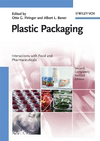At its flexographic printing facility in Winchester, Kentucky, James Combs recalls the changes label manufacturer and printer Walle Corp. had to make in order to gain certification from the Sustainable Green Printing Partnership, a nonprofit organization that certifies printing facilities’ sustainability best practices as well as regulatory compliance.
Walle Corp. received its SGP certification in 2014, but Combs says the process relied on a complete mindset change from the management team and its floor employees.
“The management team had to understand that while they are responsible for developing the program for our environmental health and safety, it’s really about involving the folks on the floor to help implement and carry that out on a day-to-day basis,” explains Combs, Walle Corp.’s director of quality, continuous improvement and sustainability.
The company, which offers a variety of film labeling solutions such as cut and stack, roll-fed, shrink sleeve and in-mold for the food and beverage, household and personal care markets, now has environmental teams that meet on a monthly basis.
Walle Corp. has already reached sustainability achievements, such as recycling 100 percent of film waste and trim, using 100 percent water-based flexo inks, reusing 99 percent of residual inks and coatings, reducing volatile organic compounds (VOCs) by 97 percent through the use of solventless inks, coatings and laminating adhesives, and reducing 95 percent of prepress waste by “going green” in its process workflow for plate making.
“The label is a long-lasting part of the container, and we do a lot of water bottle labels for our customers,” Combs says. “You can imagine how many water bottles are consumed in a year, and I couldn’t imagine having all of those labels piled up in a pile somewhere.”
But Walle Corp. isn’t alone in its goal of satisfying clients, consumers and its community by pursuing more stringent sustainability standards. As consumers and brand owners become more educated on sustainability best practices throughout the packaging supply chain, organizations such as the Sustainable Green Printing Partnership are leading the charge for sustainability education and are enabling packaging printers to pursue stricter sustainability goals through certification.
The Full Sustainable Package
Traditionally, the flexible packaging industry has focused its sustainability efforts on the package substrate, says Doreen Monteleone, treasurer for the Sustainable Green Printing Partnership and a sustainability consultant at D2 Advisory Group, representing members of the Flexographic Technical Association.
“What if that fully biodegradable package was printed at a facility that was not implementing sustainable practices? What if that printing facility, for example, was wasting energy, using higher VOC inks than necessary, not handling chemicals safely or not being proactive in seeking ways to improve its sustainability footprint?” she asks. “Would you still consider the flexible packaging sustainable?”
As more buyers are becoming educated on how encompassing sustainability really is, Monteleone says, many are looking beyond the substrate and are considering how the package was printed, ultimately finding out that not all printers are equal in their sustainable manufacturing claims. But the Sustainable Green Printing Partnership is alleviating some of those misconceptions and concerns by offering a more streamlined sustainability program to printers.
The partnership was created in 2007 after Monteleone and colleagues at other printing associations began receiving phone calls from printer members in response to Walmart’s push to become more sustainable and the need for printers to become a link in this new sustainability-focused supply chain, she says.
Representatives from the FTA, Specialty Graphic Imaging Association, Printing Industries of America, and the National Association of Printing Ink Manufacturers brought together a team of roughly 100 stakeholders representing all print processes, suppliers, print buyers, government agencies and others to develop criteria that takes “a holistic approach” to defining a sustainable printer, Monteleone explains. The end result was the SGP certification program.
“It encompasses all areas of a print operation with people, planet and profit in mind,” she says. “So it’s not a single-attribute environmental program, but one that includes environment, health and safety aspects.”
The first printing facilities were SGP certified in 2008 and today there are about 60 certified facilities across the United States and Canada, with many others in the certification process.
Getting Certified
After applying for SGP certification, companies have one year to schedule an on-site audit. Monteleone says for most companies those 12 months usually consist of trying to organize their programs and formalize their sustainability management systems to meet the certification’s requirements, such as appointing a viable sustainability committee, documenting procedures, holding environmental, safety, health and energy audits, performing indoor air quality testing and documenting specific SGP metrics.
“Although many companies are very proactive when it comes to the environment, they often lack documentation and metrics to track their progress and continually improve on their sustainability footprint,” she says.
Any printer working through the certification process can also get support through the Specialty Graphic Imaging Association’s Peer-to-Peer program, which guides applicants through the certification criteria during scheduled conference calls. Other SGP Resource Partners are also available to help their members through the process if needed.
Once printers are ready for the on-site audit, an SGP auditor will usually take an afternoon and morning to evaluate the facility’s conformance. If no corrective actions need to take place, the facility is considered SGP certified and will report on a continuous improvement project once a year and undergo another audit for recertification every other year.
“Every facility is different. Some have excellent waste reduction programs while others have installed wind turbines or solar panels,” Monteleone says. “SGP has criteria that must be met, but also requires continuous improvement. The facility has the flexibility to choose an annual project that makes sense for their operation based on its metrics.”
SGP Certification in Action
Headquartered in Oaks, Pennsylvania, Global Packaging has already seen positive changes since being certified in 2009. The company became the first SGP-certified green printer in North America in the wide web flexo category and the first member of FTA to achieve SGP status, company officials said.
Global Packaging has added several sustainability solutions, including a distillation unit to process used solvent from printing presses. The unit allows the company to capture up to 70 percent of the used solvent/ink mix, which is then reused on the presses for cleaning, says Peter Lehman, Global Packaging’s vice president of operations. Last year, the company reduced the number of wood-scrap trailers from 12 to 5 by switching from wooden to plastic pallets.
Additionally, in 2012, Global Packaging began purchasing Twinlock sleeves for use in mounting to eliminate the use of stickyback.
“In 2017, our plastic recycling company agreed to begin accepting all plastic film scrap, including polypropylene, laminations and metallized materials – all formerly disposed of in landfills,” Lehman says.
Other sustainability initiatives include reducing film gauges from 2-2.5 mil to lower gauges, utilizing re-pelletized resins in coextruded and mono-layer films, and adding corn-based resins into standard film formulas, among other adjustments.
“Sustainability efforts eliminate waste, reduce packaging and lower our carbon footprint,” says Michael Frost, Global Packaging’s president. “Additionally, SGP’s guiding principles conformed to Global Packaging’s ideology. We felt the organization could support our efforts to expand our current program and guide us toward additional sustainable business practices in the future.”
The Next Step
Other printers such as St. Petersburg, Florida-based Bay Tech Label and Canada’s Emmerson Packaging say they applied for SGP certification because it was the next step in a long-term goal for better sustainability practices.
Bay Tech Label, which specializes in flexographic printing for a number of labeling options in industrial, pharmaceutical, electrical, nutraceutical, and food and beverage markets, was certified in October 2016 after a short summer of preparation.
“We’ve been a green company for a while,” says Brenda Liles, a customer service employee and SGP coordinator at Bay Tech Label, adding that SGP certification was simply the next step toward receiving national recognition for the company’s sustainability practices.
Emmerson Packaging was the first Canada-based printer to receive SGP certification, but the company was well on its way to greener territory by following the environmental management standards set by ISO 14001.
“Probably for about 12 years or so, we really worked hard at reducing our environmental footprint along the way, and there have been some pretty drastic improvements as we’ve gone along,” says Craig Evans, vice president of marketing at Emmerson Packaging, which is headquartered in Amherst, Nova Scotia.
Since 2000, Emmerson Packaging has reduced its residual solid waste by 87 percent, lowered its water usage by 78 percent, reduced its electrical usage by 41 percent and reduced VOC emissions by more than 55 percent, according to the company website.
Over the years, Emmerson Packaging has also developed more sustainable packaging products, such as SmartPack, a recyclable, bottom-gusseted standup pouch that uses energy-curing technology to reduce the number of films required. SmartPack is also available in a biodegradable option, allowing customers to dispose of the package in their regular garbage or place in their recycle bins.
Proof is in the Numbers
“Any time you waste less, become more efficient or improve health and safety of employees, you save money and become a more viable company,” says SGP’s Monteleone.
The Sustainable Green Printing Partnership reports an average cost savings of more than $43,000 from SGP certification. The organization has also tracked benefits such as reducing energy consumption by 376,000 kilowatts per year, a savings of $25,000; an 850,000-pound reduction in waste, resulting in lower landfill and hauling costs; a $60,000 annual savings in water consumption by eliminating outdated treatment systems; and a $16,000 annual savings in solvent costs through increased recycling.
In addition, 62 percent of SGP-certified facilities have significantly reduced VOC emissions and the same percentage diverts a higher volume of materials from landfills and incineration by increasing recycling, according to the partnership. And more than half of those certified facilities report reduced energy consumption, lowering operating costs and waste.
“As more techniques and technologies become available, new opportunities arise for printers to be more sustainable,” Monteleone says. “The sustainability pathways may vary, but all pathways lead to a better, more sustainable business operation that benefits everyone.”
Sustainable Green Printing Partnership









